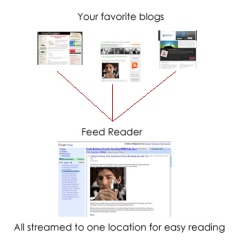RSS For Education
September 28, 2012 1 Comment

O’Keefe, K. (2007). How an RSS Feed Reader Works [Chart]. Retrieved from http://kevin.lexblog.com/how-an-rss-feed-reader-works.jpg
I can see that using Google Reader or RSS would be useful in my classroom. Employing these tools in an LD classroom might allow me to set up some categories in advance so that I could filter, somewhat, student explorations in a given area. Teachers in our school could assign reading topics to study at home so class time could be spent working and discussing.
Some of it concerns me, in that too much information can overwhelm. Having never blogged before now and only seeking research I chose to seek, I feel overwhelmed with information now. I can only imagine one of my students with Organizational Management difficulties or Time Management issues trying to negotiate all the information in a feed. Hopefully, I can play with the filters to explore how to regulate this flow.
I certainly see how this connects to ACET Standard 4 Management, 4.4 Information Management as you can select the feeds that interest you and your specific research. Certainly that selection allows for information to come straight to your computer. It is a new era for me and I will explore how to control it as I progress.